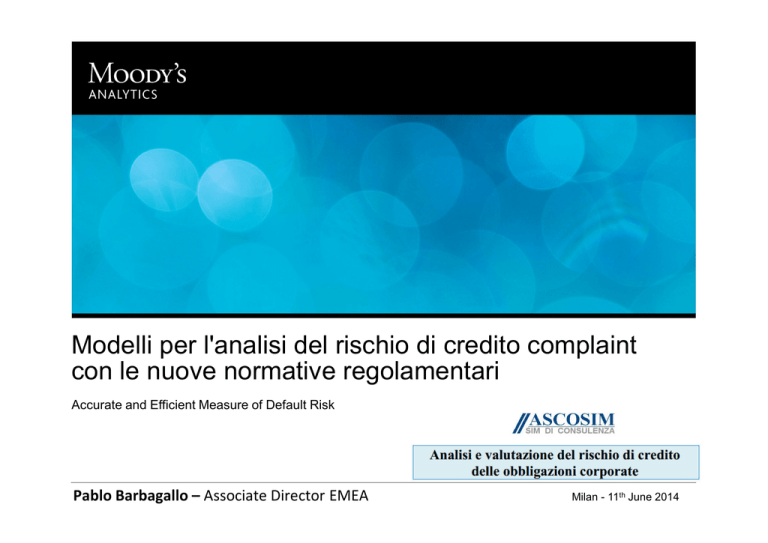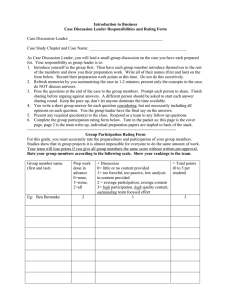
Modelli per l'analisi del rischio di credito complaint
con le nuove normative regolamentari
Accurate and Efficient Measure of Default Risk
Pablo Barbagallo – Associate Director EMEA
Milan - 11th June 2014
Our story begins with broad and deep insight from wellrespected names
Rating Implicito vs Rating
Tradizionale: Gestione del
Rischio nel Rispetto delle Nuove
Normative
Differenze fra Ratings impliciti e ‘tradizionali’?
Ratings delle agenzie
Rating impliciti o EDF
Qualitativo e a volte soggettivo
Quantitativo ed oggettivo
Ranking per classi per es. Aaa, Aa1, ecc.
Misura anche livelli numerici o “assoluti” di
rischio per es. 5.01%
Società diverse nello stesso gruppo
Granulare per es. 5.01% vs. 5.02%
Molto dinamico, aggiornamenti giornalieri
Analisi quantitativo – Possibilià di “What-if
Analysis”
Informazioni provenienti da tutte le fonti
disponibili: bilanci, prezzi di mercato, ecc.
Stabile o “through the cycle”
Rating Impliciti vs Rating tradizionali
4
Expected Default Frequency:
Società quotate in Borsa
5
Rating Impliciti vs Rating tradizionali
Analisi Quantitativa
CreditEdge e’ un modello econometrico che calcola la probabilita’ di default
(PD) o EDF di società quotate.
CreditEdge si basa sulla teoria delle opzioni (Black-Scholes-Merton) e
l’analisi empirica per calcolare la PD o EDF (Expected Default Frequency)
di societa’ quotate.
EDF e Rating implicito per un orizzonte temporale da 1 a 10 anni.
6
Rating Impliciti vs Rating tradizionali
EDF Methodology Summary
Equity is a Call Option on the Assets.
Solve for Market Value of Assets and
Asset Volatility.
Amount of Short/Long Term Liabilities
determine Default Point
Amount of Short and
Long Term Liabilities
Market Value of Equity
Market Value
of Assets
Distance to Default is the cushion
between Market Value of Assets and
Default Point, expressed as a multiple
of Asset Volatility.
MKMV’s Default Database is used to
empirically map DD to EDF.
EDF is the probability that the firm will default within the
specified time horizon.
Asset Volatility
Default Point
Distance to Default
DD-EDF Mapping
EDF
Implied
Rating
Rating Impliciti vs Rating tradizionali
7
When do Firms Default?
Rating Impliciti vs Rating tradizionali
8
When do Firms Default?
Rating Impliciti vs Rating tradizionali
9
Calcolo della Distance-to-Default (in breve)
Distribution of
Market Value of
Assets at Horizon
(1 Year)
Value
Expected Market
Value of Assets
Market
Value of
Assets
Asset Volatility
(1 Standard Deviation)
σ
Distance-to-Default
(DD)
Default Point
EDF™
Today
1 Year
Time
Distance-to-Default (DD) ≈ The number of Standard Deviations the Market Value
of Assets is away from the Default Point
Rating Impliciti vs Rating tradizionali
10
RadioShack is a very high risk company: a small gap
between its MVA and DP and excessive asset volatility
Key drivers of RSH’s EDF
No. of
Std. Dev.
$2,500mn
1
2
1.X
% Probability
68%
96%
"Normal Dist"
PD
>2%
$2,000mn
MVA $1,531mn
$1,300mn
DP $1,095mn
$500mn
$0
July 2013
July
2014
Time
Rating Impliciti vs Rating tradizionali
11
Come trasformare la DD in un EDF Rating implicito
»
EDFs are derived from an empirical
mapping of DDs to historical default
rates
»
DD = 4 maps to a 0.003% PD in
the simple BSM model, but to
a 0.4% EDFTM metric
Public firm EDFs were calibrated using
US corporates from 1980 to 2007,
including over 8,000 defaults. This is
being extended to take into account the
more recent experience.
Note: the EDF-DD curve in the graph is a stylized representation
of the actual DD to EDF mapping function
Rating Impliciti vs Rating tradizionali
12
Decomposizione di DD in µt + ct
The HP filter trend-cycle decomposition bears a resemblance to the classic
asset value dynamics model
yt
The trend
component
(“drift”) evolves
smoothly
µt = yt - ct
ct
The cyclical
component is
mean zero and
stationary
Rating Impliciti vs Rating tradizionali
Daily EDF measures and other credit risk metrics for 35,000
public entitiesI
Summary of most
relevant credit
metrics for over
35,000 entities
Side-by-side charts
for easy monitoring of
company risk and
relative performance
vs. risk
Rating Impliciti vs Rating tradizionali
I.and more than 1,500 private entities and sovereigns
Historical credit
performance of over 80
sovereigns using different
credit metrics
Analyze sovereign credit
risk vs. credit risk outlook
of the corporate or
financial sectors in the
same country
Rating Impliciti vs Rating tradizionali
Documentazione chiara e completa: No Secrets
Rating Impliciti vs Rating tradizionali
16
Expected Default Frequency:
Società non quotate
17
Rating Impliciti vs Rating tradizionali
Analisi Quantitativo e Qualitativo
Rating Impliciti vs Rating tradizionali
Output:
1-year e 5-year EDF: probabilità di default a 1 e a 5 anni.
Bond Default Rate Mapping: is the agency rating whose historical average default
rate best matches RiskCalc’s EDF
Rating Impliciti vs Rating tradizionali
Analisi indici di bilancio:
Rating Impliciti vs Rating tradizionali
Qualitative Overlay: Output
Rating Impliciti vs Rating tradizionali
Market context – Key issues for SMEs
Access to finance is key problem no. 2 for SMEs, second
only to finding customers
Key issues faced by SMEs
100
90
7.7
7.8
7.6
12.2
11.8
12.7
14.3
12.8
Percentage of respondents
80
70
60
14.6
7.7
7.7
12.4
12.2
Regulation %
Costs of production or labour %
17.4
14.6
Competition %
50
13.6
9.3
17
40
13.6
17.5
Availability of skilled staff or
experienced managers %
15.7
30
15.1
15.4
15.1
13.6
Access to finance %
20
10
24.1
27.6
21.7
20.4
10-49
employees
50-249
employees
24.1
Finding customers %
0
TOTAL - EU27 1-9 employees
SMEs
(combined)
Source: European Commission & ECB, “The Survey on the Access to Finance of Small and Medium-sized Enterprises (SAFE)”, Dec. 2011
Rating Impliciti vs Rating tradizionali
How Do We Know that the
Model Works?
23
Rating Impliciti vs Rating tradizionali
EDFs and Realized Default Rates
1-year HY EDF vs. the 1-year HY default rate
Average EDF
USSpeculative Default Rate
Baseline Forecast
16%
12%
8%
4%
0%
Jan90
Nov92
Sep95
Jul98
May01
Mar04
Jan07
Nov09
Sep12
Rating Impliciti vs Rating tradizionali
24
Defaulted Firms Behave Differently Than All the Rest
EDFs for all European corporates and for 2008-2010 defaulters
All Companies
Failed Companies 2008-2010
100
50 %
EDF Measure (%, log scale)
10
75 %
50 %
1
25 %
0.1
0.01
2001
2002
2003
2004
2005
2006
2007
2008
2009
2010
Rating Impliciti vs Rating tradizionali
25
Petroplus default on 25th January 2012
Rating Impliciti vs Rating tradizionali
26
Petroplus default on 25th January 2012
Rating Impliciti vs Rating tradizionali
27
How did the model work during the crisis?
Power Curves and Accuracy Ratios for Global Financials
2007-2010
1996-2006
100%
100%
80%
60%
40%
20%
EDF AR: 79%
# Defaults: 280
# Firms: 6,779
Percent of Defaults
Percent of Defaults
80%
40%
20%
EDF AR: 77%
# Defaults: 108
0%
0%
0%
60%
10% 20% 30% 40% 50% 60% 70% 80% 90% 100%
Percent of Population
0% 10% 20% 30% 40% 50% 60% 70% 80% 90% 100%
Percent of Population
Note: Certain government bailouts not counted as defaults
Rating Impliciti vs Rating tradizionali
28
Appendix
Rating Impliciti vs Rating tradizionali
29
EDFs alone don’t equate to credit spreads. They are a key
component of our modeled bond-level FVS.
A simplified/stylistic view of the FVS model at the bond level
Company EDF
l = ln
Expected
Loss
Term of the bond
Expected LGD (sector
and seniority-based)
Mkt Price of
Risk
Market Risk Premium
(broad market)
FVS
Correlation of Co. asset
value to market
Co.
Size
Factor
Company size
Rating Impliciti vs Rating tradizionali
30
The principal bond selection criterion for the model
portfolios is the issues’ Alpha Factors
A Bond’s Alpha Factor = OAS/FVS
» The Alpha Factors for a given month are based on values from the previous
month
Investment Universe:
» A member of ML Euro Investment Grade or Sterling Investment Grade Indices
» Sold by a publicly traded company with a Moody’s Analytics EDF credit measure
» Rated by Moody’s or S&P
Rating Impliciti vs Rating tradizionali
31
The euro IG model portfolio had positive excess returns in 64%
of the months, with a bias towards strongly positive months
Count of Euro investment grade model portfolio excess returns by month (1/07-2/2014)
Rating Impliciti vs Rating tradizionali
32
The euro IG model portfolio has outperformed strongly on
a cumulative basis
Euro IG performance vs. the ML Euro IG Corp Index (2007-2014)
Alpha Factor Portfolio
ML EUIG
160%
160%
Average Standard
Return Deviation
140%
Sharpe
Ratio
AF portfolio
6.6
3.9
1.4
Benchmark
4.9
4.1
0.9
140%
120%
120%
100%
100%
80%
80%
Dec06
Jan07
May08
Oct09
Mar11
Aug12
Jan14
Rating Impliciti vs Rating tradizionali
33
34
Stress Testing of PDs
Baseline vs. recession scenarios
Future PD
0.20
0.15
0.10
Baseline Scenario
Recession Scenario
0.05
0.00
0.00
Source: Moody’s Analytics
0.05
0.10
0.15
0.20
Current PD
Rating Impliciti vs Rating tradizionali
Firm-Level Stressed EDF Measure Examples
BL
S1
S2
S3
S4
Source: Moody’s Analytics, September 2013
Rating Impliciti vs Rating tradizionali
moodys.com
.................................................
Pablo Barbagallo
Product Specialist
EMEA Sales
+44 (0) 20 7772 1669 tel
+44 (0) 7730 910158 mobile
Pablo.Barbagallo@moodys.com
Moody's Analytics UK Ltd.
One Canada Square
Canary Wharf
London, UK E14 5FA
www.moodys.com
.................................................
© 2010 Moody’s Analytics, Inc. and/or its licensors and affiliates (collectively, “MOODY’S”). All rights reserved. ALL INFORMATION CONTAINED HEREIN IS PROTECTED BY
COPYRIGHT LAW AND NONE OF SUCH INFORMATION MAY BE COPIED OR OTHERWISE REPRODUCED, REPACKAGED, FURTHER TRANSMITTED, TRANSFERRED,
DISSEMINATED, REDISTRIBUTED OR RESOLD, OR STORED FOR SUBSEQUENT USE FOR ANY SUCH PURPOSE, IN WHOLE OR IN PART, IN ANY FORM OR MANNER OR
BY ANY MEANS WHATSOEVER, BY ANY PERSON WITHOUT MOODY’S PRIOR WRITTEN CONSENT. All information contained herein is obtained by MOODY’S from sources
believed by it to be accurate and reliable. Because of the possibility of human or mechanical error as well as other factors, however, all information contained herein is provided “AS
IS” without warranty of any kind. Under no circumstances shall MOODY’S have any liability to any person or entity for (a) any loss or damage in whole or in part caused by, resulting
from, or relating to, any error (negligent or otherwise) or other circumstance or contingency within or outside the control of MOODY’S or any of its directors, officers, employees or
agents in connection with the procurement, collection, compilation, analysis, interpretation, communication, publication or delivery of any such information, or (b) any direct, indirect,
special, consequential, compensatory or incidental damages whatsoever (including without limitation, lost profits), even if MOODY’S is advised in advance of the possibility of such
damages, resulting from the use of or inability to use, any such information. The credit ratings, financial reporting analysis, projections, and other observations, if any, constituting part
of the information contained herein are, and must be construed solely as, statements of opinion and not statements of fact or recommendations to purchase, sell or hold any
securities. NO WARRANTY, EXPRESS OR IMPLIED, AS TO THE ACCURACY, TIMELINESS, COMPLETENESS, MERCHANTABILITY OR FITNESS FOR ANY PARTICULAR
PURPOSE OF ANY SUCH RATING OR OTHER OPINION OR INFORMATION IS GIVEN OR MADE BY MOODY’S IN ANY FORM OR MANNER WHATSOEVER. Each rating or
other opinion must be weighed solely as one factor in any investment decision made by or on behalf of any user of the information contained herein, and each such user must
accordingly make its own study and evaluation of each security and of each issuer and guarantor of, and each provider of credit support for, each security that it may consider
purchasing, holding, or selling.

